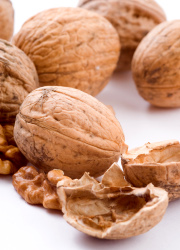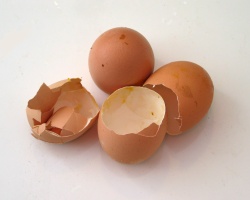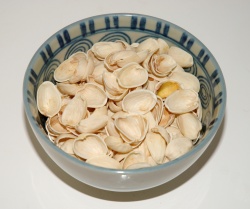How can I reuse or recycle walnut shells?
 Echoing the pistachio shells that started this site, I was thinking about walnut shells recently.
Echoing the pistachio shells that started this site, I was thinking about walnut shells recently.
It’s advised not to compost walnuts/walnut shells because the trees contain a chemical called juglone, which is toxic to some trees, plants and vegetables (especially members of the Solanaceae family – aubergine, tomatoes & potatoes) so better safe and than sorry when it comes to composting them.
Walnut shells have a number of industrial uses – a thickener in the paints & plastics industries, as a filler in explosives, and for cleaning/polishing – but less re-uses in the domestic setting. I’ve used exfoliating soaps and cleansers with tiny walnut shell particles as the abrasive element so home soap makers could use them up – but what about other reuses?
























English Walnut shells do not contain large enough concentrations of the chemical to inhibit plant growth according to Perdue University. They will however take a long time to breakdown in a compost pile.
Good uses for walnut shells are for starting fires when put in a wax paper carton like a juice/cream container or paths.
I second fire starters. My girls scout troop used a cardboard egg carton, dryer lint, and wax poured over it, to make little individual starters for campfires, ect. No reason one couldn’t add walnut shells. I’ve seen walnut shells made into xmas tree ornaments, but you have to have 2 perfect halves, and glue a ribbon inbetween for hanging.
Oh, a hinge, to make a tiny box! Takes more skill and patience than I have, but still.
But the packing them in cardboard juice cartons or cardboard paper tubes, perhaps with a bit of wax and or dryer lint, and adding them to fires sounds doable.
Matthew Mead has an easy way to make tiny gift boxes from walnut shelves. Once you’ve removed the nut, place a tiny goodie or gift inside the shell, tie the two halves together with gold thread or red yarn. Easy-peasy.
I would most definitely use them for art supplies! When I was a kid, my art teacher had us design faces using old walnut shells. Good way for kids to get creative.
Break the shells, or leave in halves, use as garden/pot mulch.
The juglone component may also help keep weeds down.
I like the fire lighter idea. It has been suggested using the broken shells as mulch around veges to stop snails from attacking plants. Does this work?
I would imagine they eventually get mixed in with the soil and if so the problem again with the chemical, or if not maybe good aerating mulch for soil.
I remember reading that the floor of the Globe Theatre in Elizabethan London was made of pig shit and walnut shells, compacted down to a very hard and polishable surface. As an owner of healthy, free-ranging pigs, I can vouch for the sticky, solid consistency of pig shit.
I thought that I may have some items someone is interested in.
I have boxes of Hickory nuts that you will not believe how big
they are. These nuts (Out of the hull) are as big as (some) Black Walnuts (In the hull). If anyone is interested you may send me
a E-Mail.
Walnut shells with water removes plaque from teeth.
http://diyprojects.tips/this-is-how-to-remove-plaque-naturally-at-home-in-natural-conditions/
I think the shells of hazel nuts have a texture like good quality wood. Would it be possible to recycle them, like making chipboard to make furniture instead of cutting down trees? It seems a shame to just throw them away.
where can I buy 1/2 english walnut shells for arts & crafts, even 1/2 plastic shells would be good. thank you milly
I DID NOT ASK HOW TO RECYCLE ENGLISH WALNUT SHELLS. PLEASE REREAD. I ASKED WHERE CAN I BUY 1/2 ENGLISH WALNUT SHELLS FOR ARTS & CRAFTS ALSO PLASTIC WOULD BE GOOD THANK YOU MILLY
Walnut shells were favoured as a filing for pin cushions, and even today crushed shells can be used to fill hone made pin cushions. The abrasive quality and the slight residue of walnut oil keeps your pins sharp and rust free. Just pound them to a fine consistance.
MILLY, ITS RUDE TO SHOUT!